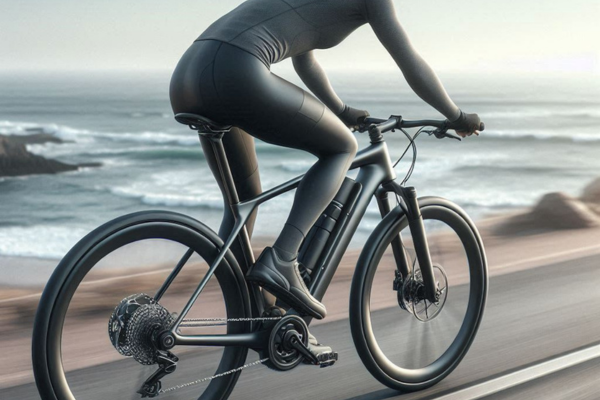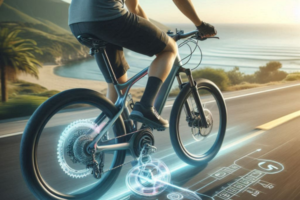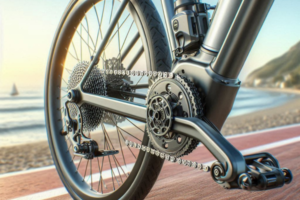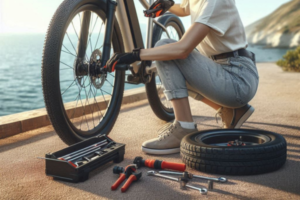🚴♀️ Lightweight Accessories: The Smart Way to Gain Speed Without Losing Safety
When it comes to riding faster on your electric bike, many riders think only in terms of motor upgrades or battery range. But there’s another way to improve performance that’s often overlooked: your accessories. The right lightweight accessories can dramatically reduce drag, improve efficiency, and increase overall speed—without compromising your safety or comfort.
Every extra gram your e-bike carries means more work for your motor, especially on inclines or during acceleration. Reducing weight doesn’t just make the bike feel lighter—it actually extends your range, enhances responsiveness, and lowers energy consumption. And when this is done smartly, you never have to sacrifice visibility, protection, or utility.
⚙️ Why Weight Matters on an E-Bike
Electric bikes are built for power and endurance, but they still obey the same rules of physics as any other bicycle. The heavier the load, the more energy it takes to move. Accessories like racks, mirrors, lights, and fenders add weight—and when these aren’t optimized, they slowly chip away at your performance. That weight impacts your ability to climb, accelerates battery drain, and reduces top speed.
The solution lies in choosing accessories made from lighter, durable materials that retain their functionality. For example, a carbon fiber rack can be half the weight of a steel one and still carry your daily essentials. A slim LED headlight offers brightness with minimal bulk. It’s not about stripping your e-bike bare—it’s about upgrading it with intention.
🔎 Key Categories to Focus On
- Lights: Look for rechargeable LED lights with aluminum or plastic casings instead of metal bodies. They offer excellent illumination with much lower weight.
- Rear racks: Opt for minimalist racks made from lightweight alloys or carbon blends. They’re perfect for city commutes without excess steel mass.
- Helmets: Aerodynamic helmets designed for road cycling reduce drag and often weigh 100–200g less than traditional models.
- Fenders: Plastic or composite fenders are lightweight and effective, especially those with low-profile mounting systems.
- Mirrors: Bar-end or helmet-mounted mirrors made from acrylic are safer, lighter, and more aerodynamic than glass.
📊 Comparison Table: Traditional vs. Lightweight Accessories
| Accessory | Traditional Model (Approx.) | Lightweight Alternative | Weight Saved |
|---|---|---|---|
| Rear Rack (steel) | 2.5 kg | 1.2 kg (aluminum) | 1.3 kg |
| Fenders (metal) | 1.1 kg | 0.5 kg (polycarbonate) | 0.6 kg |
| Helmet (commuter) | 450 g | 280 g (road aero) | 170 g |
💡 Choosing Wisely: It’s Not Just About Cutting Weight
Remember, it’s not about choosing the lightest version of everything—it’s about finding the optimal balance between function and form. Your lights must still shine bright. Your rack must still carry what you need. Your helmet must still protect your head. But by switching to lightweight materials and streamlined designs, you’ll ride faster, feel less fatigue, and enjoy a more responsive e-bike experience.
💡 Insight: You don’t need to go faster—you need to ride smarter. Lightweight accessories let you do both.
🧼 How to Maintain Lightweight Accessories for Lasting Performance
Choosing lightweight accessories is only the beginning. To truly benefit from improved speed and reduced drag, your accessories must be kept in optimal condition. Poorly maintained components—even if light—can become liabilities, adding friction, rattling noise, or even creating safety hazards. Regular care is the secret to long-lasting performance and rider confidence, especially in humid or coastal climates where wear accelerates.
🛠️ Weekly Care Routine for Lightweight Accessories
Once a week, dedicate just 15–20 minutes to review and clean your key accessories. This prevents dirt accumulation, metal fatigue, and subtle degradation that can lead to early failure or speed loss.
- 🧽 Wipe down surfaces with a damp microfiber cloth: Removes salt, sand, and grime—especially important after coastal rides.
- 🔩 Inspect all mounting points and fasteners: Lightweight mounts can loosen from vibration, reducing stability and alignment.
- 🧪 Apply corrosion protection: Use silicone spray or dielectric grease on bolts and metallic contact points once a week.
- 💡 Test functionality: Ensure that lights work, racks stay firm, and mirrors remain aligned without vibration distortion.
🌦️ Humidity and Salt: Invisible Threats
Humidity and salty air can accelerate corrosion and electrical failure. Even non-metallic components like plastic fenders or polymer mirrors degrade faster if not cleaned regularly. Riders in tropical or coastal areas must take extra steps to keep gear clean and dry after every ride.
Simple measures such as rinsing with fresh water after exposure to sea air, drying accessories thoroughly, and storing the bike in a shaded or ventilated area make a big difference over time.
📊 Table: Maintenance Needs by Accessory Type
| Accessory | Common Threat | Suggested Action |
|---|---|---|
| LED Lights | Moisture ingress, connection rust | Clean contacts weekly, apply dielectric grease monthly |
| Rear Rack | Loose bolts, frame rattling | Torque-check all mounts weekly |
| Mirrors | Vibration, misalignment | Re-adjust and tighten, use anti-slip washers if needed |
| Fenders | Cracking or loosening over time | Check brackets monthly, inspect for micro-fractures |
🔧 Build a Dedicated Maintenance Kit
A small kit makes weekly care easy and efficient. Here’s what to include:
- 🧼 Microfiber cloths
- 🧪 Anti-corrosion spray or silicone protectant
- 🔩 Mini torque wrench or hex key set
- 🧴 UV-protective polish (especially for plastic accessories)
- 💨 Small air blower or compressed air for connector cleaning
💡 Reflection: Lightweight doesn’t mean fragile—but it does mean attentive. Treat your accessories with care, and they’ll reward you with speed, silence, and style.
⚠️ Mistakes to Avoid When Selecting Lightweight Accessories
Lightweight accessories can transform your e-bike experience, but only when chosen and installed correctly. Many riders make the mistake of selecting products that are either too fragile, poorly designed, or improperly installed—sacrificing stability and safety for minimal weight savings. To avoid these costly errors, it’s crucial to understand what to watch for and how to balance performance with durability.
🚫 Mistake 1: Choosing the Lightest Option Without Considering Strength
Some products boast ultra-light construction but lack the strength required for everyday riding. Fenders that flex too much, mirrors that vibrate constantly, or racks that bend under load may offer initial savings in weight, but they compromise performance and longevity.
- What to do: Prioritize accessories that use high-strength materials like carbon fiber composites, reinforced polymers, or aircraft-grade aluminum. Always verify manufacturer load ratings.
🔧 Mistake 2: Poor Installation or Insecure Mounting
Improper installation can nullify the benefits of even the best-designed accessories. Misaligned fenders, loose bolts, or incorrect torque can result in vibration, loss of control, or even damage to your e-bike frame.
- What to do: Always follow the manufacturer’s instructions precisely. Use a mini torque wrench to tighten bolts correctly and apply thread-locker if recommended.
🌦️ Mistake 3: Ignoring Environmental Compatibility
Materials that work well in one environment might fail in another. Lightweight components can become brittle in cold climates, soften in extreme heat, or corrode in humid and salty conditions—especially if not treated properly.
- What to do: Choose materials with weather resistance specific to your region. For coastal areas, prefer anodized or sealed finishes; for high UV zones, select UV-resistant polymers or apply protective coatings.
📉 Table: Mistake vs. Impact vs. Recommended Action
| Mistake | Negative Outcome | Solution |
|---|---|---|
| Using ultra-light plastic mirrors | Constant vibration and low visibility | Use aerodynamic acrylic mirrors with secure mounts |
| Over-tightening carbon mounts | Cracks in accessory or bike frame | Use torque wrench and carbon-safe assembly paste |
| Neglecting moisture protection | Corrosion, sensor errors, loose bolts | Apply dielectric grease, clean weekly, use coated parts |
🚴♀️ Real-World Tip: Test Under Real Conditions
Don’t wait until you’re on a busy road to learn that your lightweight fender shakes or your rack rattles. After installing any new accessory, test it under your usual load and road conditions. Ride over bumps, accelerate quickly, and make sharp turns. If anything moves, buzzes, or shifts—it needs attention.
💡 Reflection: Lightweight gear should simplify your ride—not complicate it. Choose quality, install with care, and test with confidence.
📆 Monthly Maintenance Routine for Long-Term Performance
No matter how high the quality or how well an accessory is installed, regular inspection is what keeps it performing at its best. A monthly review of your lightweight gear can prevent minor issues from becoming costly problems and ensures that your bike continues to deliver maximum speed, safety, and style. Think of this routine as a “tune-up for trust”—a moment to reconnect with the finer details of your ride.
🔍 What to Check Every 30 Days
Set aside 30 to 45 minutes each month to go through this focused inspection list. It’s not about over-maintenance—it’s about smart foresight.
- 🔩 Retorque all bolts and fasteners: Lightweight components are more sensitive to vibration. Use a torque wrench to ensure nothing has loosened over time.
- 🧽 Deep-clean contact points: Where racks, mirrors, or fenders meet the frame, build-up of grime or oxidation can silently degrade performance.
- 🧪 Reapply anti-corrosion spray or UV protectant: Especially on aluminum racks, composite fenders, or plastic light casings exposed to sunlight and humidity.
- 💡 Perform a functional stress test: Ride your bike under typical conditions with weight on racks or bags and monitor how accessories respond—listen for noise or shifting.
🌧️ Special Steps for Coastal and Tropical Areas
In humid or salty-air environments, lightweight materials are more prone to corrosion and fatigue. If you live near the coast or in a tropical climate, incorporate these additions into your routine:
- 💨 Spray-clean accessories after rides using fresh water to remove salt residue.
- 🔌 Apply dielectric grease to electrical connectors monthly, especially on lights or displays.
- 🌤️ Keep your bike stored away from direct UV light or use a protective cover with thermal lining.
📊 Table: Monthly Task Impact on Speed and Safety
| Maintenance Task | Purpose | Performance Benefit |
|---|---|---|
| Retorque mounts | Prevent loosening and vibration | Quieter, more stable ride |
| Reapply protectants | Prevent UV damage and rust | Longer accessory lifespan |
| Stress test under load | Detect hidden wear or movement | Enhanced safety and reliability |
🧰 Tools to Keep Handy for Monthly Care
Build a simple monthly kit so you’re always ready. It can include:
- 🔧 Mini torque wrench
- 🧼 Soft detailing brush and sponge
- 🧴 Silicone-based protectant and UV spray
- 🧪 Dielectric grease
- 📋 Logbook or checklist to track wear patterns
💡 Reflection: Speed doesn’t only come from power—it comes from preparation. When you inspect with care, you ride with clarity.
💬 Frequently Asked Questions (FAQs)
Do lightweight accessories really improve e-bike speed?
Yes, especially when weight reduction is combined with aerodynamic design. Lightweight accessories reduce total mass, which means the motor works less to maintain speed—improving battery efficiency, acceleration, and range. While the difference may seem small individually, the combined effect can be significant.
Are lighter components more fragile?
Not necessarily. Modern materials like carbon fiber, polycarbonate, and aircraft-grade aluminum offer both strength and reduced weight. The key is to buy quality, certified accessories and maintain them correctly. Fragility often comes from cheap or poorly installed products.
Which accessory upgrades offer the most benefit?
Start with the essentials: LED lights, aerodynamic helmets, compact fenders, and a minimal rear rack. These items affect both safety and performance. Look for designs that cut wind resistance and use weather-resistant materials.
How can I tell if an accessory is causing drag?
Unusual rattling sounds, noticeable resistance, or reduced speed after installation are warning signs. Misaligned fenders or large, non-aerodynamic baskets often act like parachutes. A short test ride with and without the accessory can reveal the difference.
Do I need to clean my accessories even if they look fine?
Absolutely. Dust, salt, and invisible grime can affect performance, especially in connectors or joints. Regular cleaning ensures lightness doesn’t come at the cost of corrosion or reduced functionality.
💖 Final Thoughts: Lightness as a Philosophy
Speed isn’t only about how fast you go—it’s about how you feel while riding. Lightweight accessories contribute to that experience by removing resistance, distractions, and limitations. But they also remind us that performance comes from balance. The smartest upgrades are those that amplify speed without compromising safety.
Each gram saved is a choice. Each adjustment is a step toward refinement. When your e-bike is equipped with the right accessories, tuned with intention, and cared for with love—you don’t just ride faster. You ride freer.
💡 Inspiration: Speed isn’t about force. It’s about removing what’s unnecessary—until only excellence remains.
🌍 Join the Conversation: What Makes Your Ride Lighter and Smarter?
Now that we’ve explored the best strategies and practices, we’d love to hear from you. Have you found an accessory that changed your riding experience? Do you have a maintenance habit that keeps your gear light and reliable? Or maybe you’ve made mistakes you’ve learned from—those lessons matter too.
Share with us:
🚴♀️ What’s your go-to lightweight accessory and why?
🔧 Do you follow a regular maintenance schedule?
💬 Which upgrade made the biggest difference in your speed or comfort?
Leave your tips, routines, and discoveries in the comments. Let’s build a community of riders who understand that going faster doesn’t mean doing more—it means doing better. Together, we’re not just moving forward. We’re moving smarter. 🌬️🚴♂️✨



